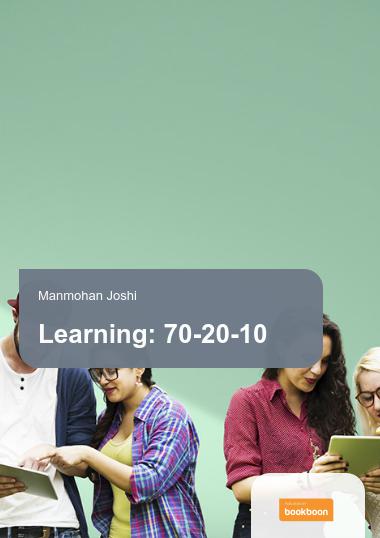Why eLearning is a modern fit for the 70-20-10 model

The 70-20-10 model is an established approach to how we learn at work, and it is used in many organisations all over the world. Although it is almost 40 years old, the model is still applicable today and certainly not something the learning industry should leave in the digital dust of eLearning.
As a global provider of eLearning, we are asked by many 70-20-10 users how eLearning fits into the methodology.
Thanks to eLearning’s short, precise, relevant and shareable digital training content, the model’s percentages that once applied to traditional learning maintain their relevance in the modern learning landscape.
The model
The 70-20-10 model is a strategic workplace learning framework that has continued in popularity as it can be used to increase employee effectiveness by supporting the three ways people learn. The model suggests that 70% of learning is observational and experiential, 20% comes from interactions with others and 10% occurs through structured training such as courses or online-learning programmes.
The 70-20-10 model maximises effective learning
The effectiveness of employee learning and development is often questioned by budget holders. Those in charge of L&D are pressured not only to justify the money spent on training but to also be able to produce proof of a return on investment. The model can be used as a strategy to improve today’s workplace performance, maximise the effectiveness of learning and development and thus produce an evident return on investment.
How eLearning elements fit with the 70-20-10 model
When it comes to the effectiveness of learning and development resources, the 70-20-10 model, when combined with eLearning, delivers significant value and is widely used in training by businesses, large and small, all over the world. (1) Applying modern eLearning to the model is a fantastic way to structure a digital training programme.
The 70%
ELearning is the fastest route to applying and experiencing new skills
According to the model, learning occurs through daily practice. It is important that L&D professionals look to eLearning platforms that provide short-form, portable and easy to access content so that employees spend less time learning and more time applying and using their new skills in the workplace.
eLearning materials provide learners with faster upskilling than traditional training methods because of the time it takes to consume them. Training through short, clear and precise ‘micro-learning’, such as a few pages of an eBook or a quick video, allows employees to apply their learning in the shortest time possible — a matter of minutes.
Training content should only be as short as possible and as long as necessary. This especially applies to microlearning as it is used daily in the workplace for specific learning needs. This will result in a faster turnaround period than traditional learning and a quick return on investment without jeopardising quality.
Expert content allows learners to learn through observation
It is beneficial for L&D managers to work with a digital programme that produces original content created by industry experts. Consuming training materials from business owners, mentors, coaches, and professors allows employees to learn through observation from real-life examples provided by experts in the topic or field in which they are training.
This personalised approach to training gives learners a direct connection with the expert’s own relevant experience, fostering an effective experiential learning experience that would not be achieved through traditional learning without management sending employees to a class, lecture or talk.
The 20%
ELearning encourages collaboration through social learning
Social learning happens with and through other people, like coworkers. It is important that managers use eLearning to promote a culture of proactive social learning as well as a more personal approach to development. Digital training platforms are a fantastic tool to support and encourage social learning in the workplace.
For truly effective learning to occur, employees need not only to spend time learning on their own but also use the social features of digital training platforms to access an environment of effective expression, open communication, and group cohesion.
It is essential that those in charge of learning look to digital learning programmes that encourage collaboration through features that, similarly to social media platforms, allow learners to share content and notes as well as recommending learning materials to friends and coworkers. This is a more cost-effective and time-efficient approach to social learning than formal, classroom-based group work.
ELearning supports a blended learning structure
It is crucial that those in charge of learning within an organisation encourage employees to share their ideas, questions, gaps and strengths and listen to each other. Social learning, forums, group sessions, and mentors support a blended learning structure when combined with fit-for-purpose eLearning. (2) eLearning solutions support the idea of a personal learning environment as well as a social learning experience.
An eLearning environment enables an employee to collect information at one point to make use of it without loss of time, reflect on what learning is taking place, share the knowledge gained with others on the online platform using sharing tools and receive feedback and recommendations from other learners. This will result in greater connectivity and a faster, deeper understanding of the learning content.
The 10%
ELearning is the best way to provide quality training
One misconception is that the 70-20-10 model is anti-training, which is just not true. Training makes up 10% of the model and short-form digital training can ensure the learning content that employees consume is up-to-date and relevant. This is something that traditional classroom training cannot provide. In a blended learning structure, eLearning can also be combined with traditional training allowing employees to attend online seminars from anywhere without sacrificing a whole day away from the office.
The ability to choose relevant learning content
Because digital learning platforms such as eLibraries can store a large variety of content, it gives employees the power to decide which training material is relevant, compelling and helpful to them. This fit-for-purpose approach to learning is something which, simply because of space and time-restrictions, classroom training sessions cannot offer.
Employees’ roles and skill gaps vary massively meaning no two learners need to develop the same set of skills. This means that a classroom training setting can often work to the disadvantage of employees who aren’t on the same skill level.
eLearning allows learners take their training into their own hands by accessing a broad range of topics while skipping the content they don’t need, taking a considerable amount of guesswork out of the hands of L&D professionals.
Fast access to up-to-date materials
Because of the fast-paced, digital nature of eLearning, employees are provided easy access to up-to-date content. To ensure their employees aren’t consuming dated learning content, it is important that managers look for eLearning programmes that are consistently updating and adding new material, ensuring users have access to up-to-date, brand new information. This feature of eLearning also removes a step in the traditional training process: training the teacher.
Quality training content is the foundation of all learning
Those in charge of learning within an organisation should look at short, precise and high-quality eLearning material as a foundation upon which to build everything else up. Experiential and social learning can only occur through following great training content and quickly applying newly-learned skills. If the learning foundation is solid, the experiential and social learning that follows will likely also be more active and successful. (3)
ELearning allows learners to apply their skills quickly through short-form expert-based content, access social learning opportunities to foster sharing of training material and take charge of their own learning by choosing quality digital learning content that is relevant to them. These elements, unique to digital training, make eLearning a fantastic modern approach to the 70-20-10 model.
eLearning supports the three ways the model suggests employees learn best. Combining the model with digital training promotes a successful implementation of learning programmes, increased employee effectiveness and a return on investment.
Thomas Buus Madsen is the COO and co-founder of Bookboon, often described as the Netflix of eLearning. By making its soft skills eLibrary incredibly easy to use and only publishing industry-leading experts, Bookboon boasts some of the highest usage rates in the digital learning sector.
(1) https://enterprisestudy.com/Blog/The-702010-learning-theory-explained
(3) https://elearningindustry.com/apply-70-20-10-model-learning-development




